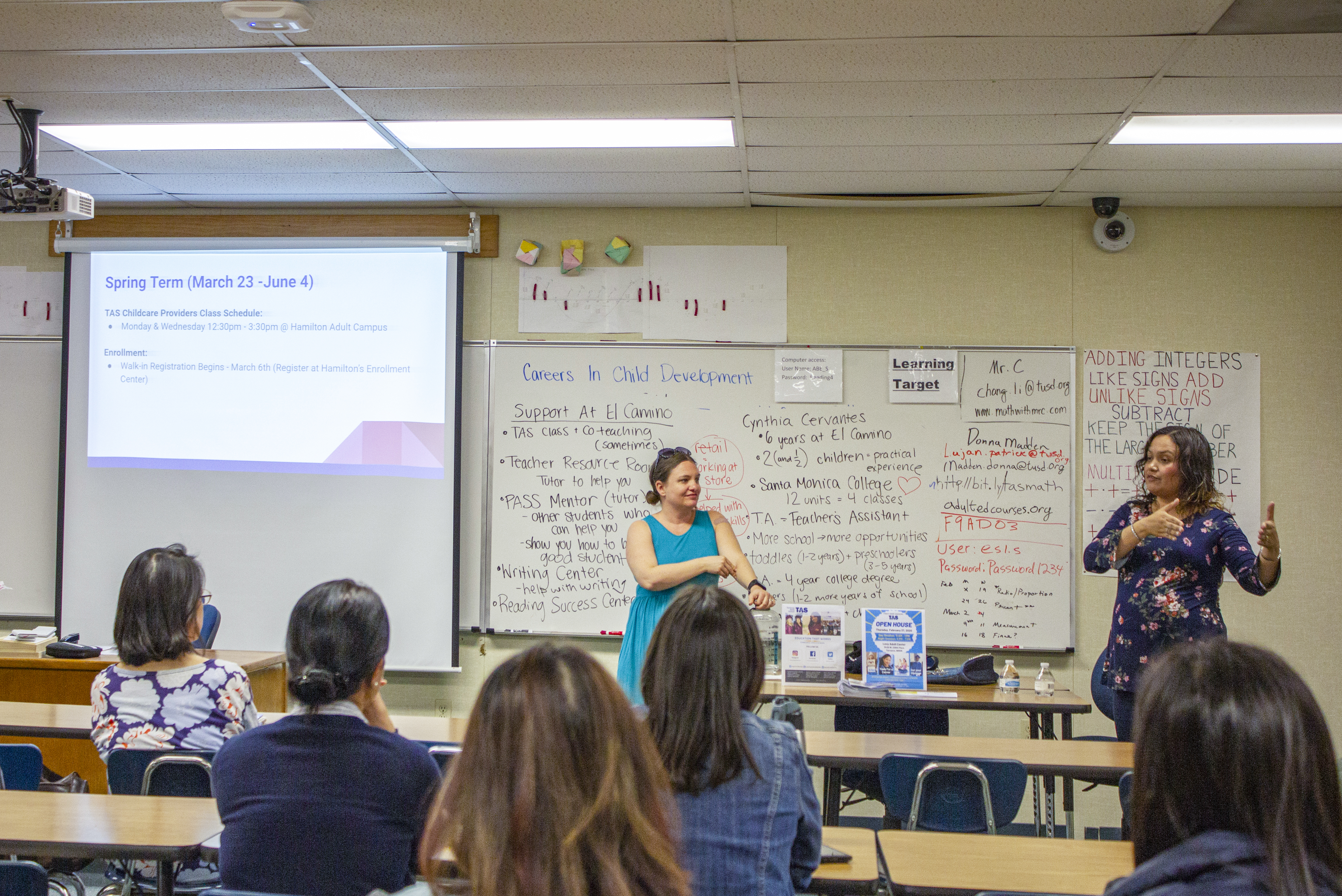Supporting ESL & ABE/ASE Students to Career Success through IET Classes
Submitted By: Hilary Estes
South Bay Adult Education Consortium(El Camino)
Website: https://www.tusd.org/tas
Type of Practice: Program Development / Curriculum / Classroom
Program Area(s): ABE / ASE, ESL / EL Civics / Citizenship, CTE / Workforce Prep / Pre-apprenticeship
Region: Los Angeles Basin
Consortia Involved: South Bay Adult Education Consortium (El Camino)
Program Overview
CTE teacher observations determined ESL and ABE/ASE students struggled in CTE classes due to language barriers. In response to this observation, Torrance Adult School implemented a number of Integrated Education and Training models to support learners.
The Program of Practice
CTE teachers observed that ESL and ABE/ASE students were struggling in CTE classes because of language difficulties. Additionally, teachers observed that even some students who were passing these classes did not necessarily have the necessary language skills to succeed in the workplace.
The Response
Torrance Adult School implemented a number of Integrated Education and Training (IET) classes in order to bolster the success of our ESL and ABE/ASE students in CTE classes and employment. Over the past four years, we have used a variety of IET models to provide support for our ESL and ABE/ASE students in CTE.
Allied Health
In Fall 2018, we piloted a Medical Terminology class that was co-taught by an ESL instructor and an Allied Health instructor. In December 2018, 19 staff members attended a training on the I-BEST model. The medical terminology class was followed in Winter and Spring 2019 by two Allied Health classes that were co-taught by Allied Health and ESL instructors following the iBest model. The Pharmacy Tech class in Spring 2019 that was co-taught by the same two instructors who had taught the Medical Terminology class was composed of 50% ESL and ABE/ASE students, the highest percentage that we had ever had. Over the next several semesters, we piloted a number of different models of providing IET support in a less resource-intensive manner, including having ESL and CTE teachers co-teach for part of the time and an alternating teaching model. When a moderate level of support was provided, ESL and ABE/ASE student participation was also moderate. Even as higher percentages of ESL and ABE/ASE students enrolled in the programs, the job placement rate for these programs remained above 90%.
Child Care
In Fall 2018, we also implemented a Child Care class designed to prepare students for transition to credit-bearing classes at our local community college and a pre-apprenticeship Construction class. While the Construction class did not prove to be a good match for the needs of our student population, we continued to develop the Child Care pathway over the next several semesters. In Winter and Spring 2019, students participated in a preparation class and then transitioned to a community college class which was co-taught by an ESL instructor and a community college Child Development instructor using the iBest model. Additionally, Torrance Adult School ran a weekly support lab in which the ESL instructor pre-taught and reviewed key concepts from the college class and helped students with writing. Of the dozen students who participated in this cohort, one had to drop the class due to a health issue. All the rest of the students went on to earn an A or B in the class. This collaboration continued during the 2019-2020 school year and was discontinued due to funding constraints in the 2020-2021 school year.
Computers & Business
Similarly to the other CTE fields, we implemented a number of different IET models in our business and computer applications department. In different semesters, we implemented a full I-BEST model, part-time co-teaching and an alternate teaching model.
The Unique Features of the Program
*Robust pathways include preparation classes and support in classes that lead to industry-recognized credentials.
*Torrance Adult School continues to pilot a variety of different models of providing IET support to ESL and ABE/ASE students in a cost-effective manner
The Outcome
We created a transition program into CTE for our ESL and ABE/ASE students and saw evidence of the success of the program through:
-CTE and Language Support Teacher observations that ESL and ABE/ASE students' language and content skills improved
-Higher number and percentage of ESL and ABE/ASE students participating in CTE courses
In Pharmacy Tech, for example, 20% (3/15) of students in the first Pharmacy Tech for which we have data were ESL or ABE/ASE. The next semester, when an I-BEST model was implemented and the class was co-taught by the same instructors who had taught Medical Terminology the previous semester, 50% (9/18) students were ESL or ABE/ASE students.
-Maintained job placement rates of 90-95% in Allied Health fields in cohorts with higher percentages of ESL and ABE/ASE students
-College course completion rates above 90% and 100% pass rate for Child Development students in our supported cohorts
-Video about the program: https://drive.google.com/drive/folders/19SzO3Pn5cW7kujda8iUW0vGhUuEgJMBF?usp=sharing

